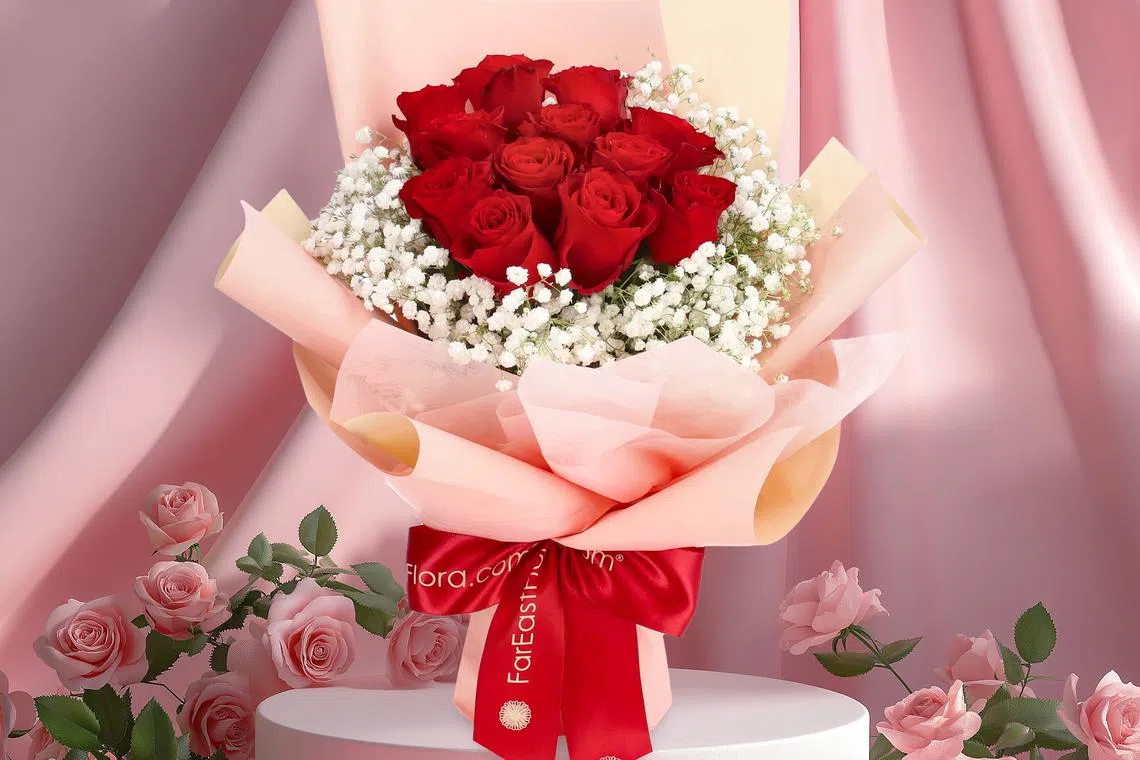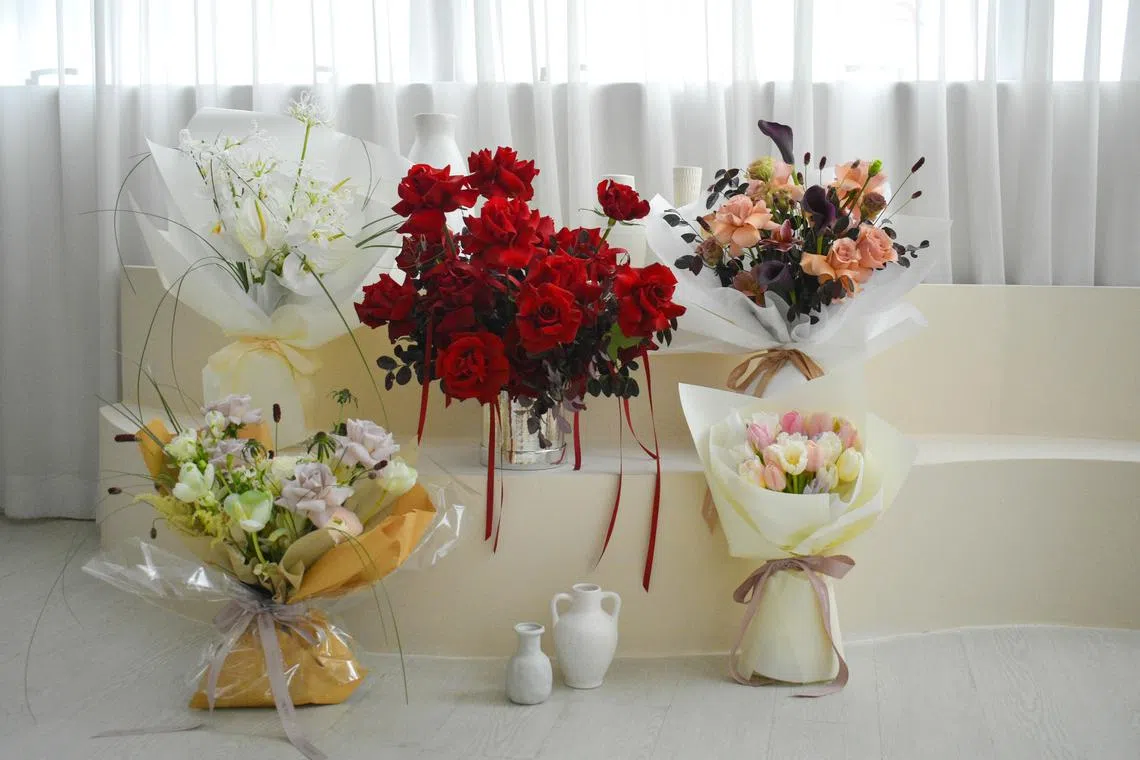Red roses reign, but alternatives are blooming
These blooms remain a popular choice for Valentine’s Day, but more people are exploring other options for loved ones

ROSES are red. Violets are blue. Is your Valentine’s Day bouquet traditional or new?
Roses, particularly red ones, have long been synonymous with Valentine’s Day. As expected, demand for the flower of love remains strong, with the global rose industry valued at US$32.99 billion and projected to grow 6.94 per cent annually through 2030. Each Valentine’s Day, an estimated 250 million roses are produced globally for the occasion, says the Society of American Florists.
But shifting trends and rising costs are reshaping the stereotype of all-red roses as the ultimate declaration of love. Florists are reporting a growing interest in roses of other hues, and even other floral varieties for Feb 14 bouquets.
This year, leading florist and plant importer Far East Flora reported a 15 per cent year-on-year increase in orders for roses for Valentine’s Day.
General manager Sarah Yong says that while classic red roses make up about three-quarters of their Valentine’s Day orders, other rose colours are gaining popularity. Pastel colours such as blush pink and lavender are gaining traction, she adds.
Red roses are typically priced “slightly higher” than those of other colours. For instance, a bouquet with six red roses costs S$119, and a similar arrangement with six pink roses, S$109.
Another popular florist, The Florté, has observed a similar shift. “The demand for red roses remains stable due to their strong association with Valentine’s Day, but other colours are gaining in popularity,” says its marketing executive Akimi Shibuya. “Customers often choose non-red roses not necessarily because of price, but rather for aesthetic reasons. Some prefer the look of non-traditional rose arrangements; others are drawn to unique floral designs that go beyond classic red roses.”
Alternative colours, particularly pink, white and even maroon roses, now account for about a quarter of The Florté’s total rose sales for the occasion. This year, 40 per cent of their Valentine’s Day orders are rose bouquets, slightly up from 38.6 per cent last year.
At The Florté, an arrangement featuring 25 stalks of red roses is priced at S$209, and a bouquet of six dusky roses paired with deep purple calla lilies and maroon foliage, costs S$198.

Similarly, Sailesh Balasubramanian, general manager at Flower Chimp, notes that red roses make up 50 to 60 per cent of this year’s Valentine’s Day rose sales, and non-red roses, for 30 to 40 per cent. Notably, pink roses have surged in popularity, rising from 20 per cent in 2019 to 40 per cent this year.
“It’s not about pricing, as the prices are similar. More people want variety nowadays,” says Balasubramanian. “You can’t send the same red roses every year.”
Old is gold
For some, however, tradition is non-negotiable. Dan Mason, 52, a director of a consultancy firm, has never considered anything besides red roses for Valentine’s Day. “Anything else would be frowned upon” by him and his wife, he says.
Like many commodities, the cost of roses hinges on weather conditions, global supply chain issues and rising freight costs. Another key factor is the overlap of Chinese New Year and Valentine’s Day, which affects supply from China, a major rose exporter.
To manage this, florists are sourcing from Europe and South-east Asia, though these markets are generally more expensive. Both Far East Flora and Flower Chimp report a 10 to 15 per cent increase in rose prices this year; The Florté reports a S$1 to $2 rise for each bundle (10 to 20 stalks).
Despite this, Far East Flora has maintained its pricing for a 50-red-rose bouquet in the S$400 to S$500 range; Flower Chimp has kept its 50-rose bouquets at between S$250 and S$300. The Florté has also held firm on pricing, selling a 48-stalk bouquet at S$300, the same as last year.
Kelvin Tay, 50, a director of operations at a semiconductor company, spends around $160 on a bouquet of red roses for his wife of 22 years. He even handpicks them individually with his daughter.
“When it comes to Valentine’s Day, the price of roses escalates,” he says. “But price is not a factor, as roses are always worth it.”

Beyond fresh roses
Another growing trend is preserved roses, which are popular “among those who want a long-lasting keepsake of their love,” says Yong.
At Flower Chimp, these now account for a fifth of Valentine’s Day sales, with Balasubramanian calling them “one of the fastest-growing categories in Singapore”.
Trevor Chelliah, 49, an educator, often opts for preserved red roses for his wife and daughter, as they are “long-lasting and come in beautiful packaging” – though they can be as pricey – at nearly S$200 for a bouquet of 25 stalks.
Meanwhile, non-roses are also carving out a space in Valentine’s Day bouquets.
Aloysius John, 59, an electrical engineer, opts for non-rose bouquets for Valentine’s Day. Every year, he buys his wife a bouquet of daisies, her favourite flowers. “Roses are lovely, but daisies are what truly make her smile. It’s more meaningful to get her what she actually likes,” he says.
Balasubramanian says that non-rose bouquets remain a smaller segment, contributing to under 20 per cent of sales this year, though more such arrangements were sold this year than last year.
At Flower Chimp, more than two-thirds of customers are opting for mixed-flower arrangements, with carnations and lilies being among the top alternative picks. Similarly, The Florté reports that 61 per cent of its Valentine’s Day sales comes from non-rose bouquets such as orchids and tulips, though these arrangements include one or two stalks of roses.
“Any price variation typically depends on factors such as the bouquet size and the type of flowers used, and the prices of non-roses rival that of red roses,” says Shibuya.
Looking ahead, the floral market is likely to continue diversifying as consumers seek more personalised options. The rise of non-red roses and mixed bouquets is expected to gain further momentum.
Alongside this, the demand for preserved roses is likely to increase, as their long shelf life makes them an appealing choice for romantics seeking longer-lasting tokens of their affection.
Nevertheless, one thing appears certain. Whether red or pink, fresh or preserved, roses will probably remain the definitive symbol of love this Valentine’s Day and beyond.
Decoding Asia newsletter: your guide to navigating Asia in a new global order. Sign up here to get Decoding Asia newsletter. Delivered to your inbox. Free.
Copyright SPH Media. All rights reserved.



